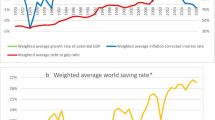Abstract
This paper provides some empirical evidence on one of the most controversial theoretical implications of the new open economy literature, which refers to the role of the current account in the international monetary transmission mechanism. In order to throw some light on this issue, two structural VAR models are estimated separately for 14 industrialized countries. The main empirical results highlight the importance of the role of nominal disturbances for current account fluctuations. Additionally, it is found that expansionary nominal shocks generate temporary current account surpluses, whose size is positively correlated with the openness of the individual countries. JEL no. C32, E40, F41, F42
Similar content being viewed by others
References
Bergin, P. (2003). Putting the ‘New Open Economy Macroeconomics’ to a Test.Journal of International Economics 60(1): 3–34.
Bergin, P. (2004). How Well Can the New Open Economy Macroeconomics Explain the Exchange Rate and Current Account? NBER Working Paper 10356. National Bureau of Economic Research, Cambridge, Mass.
Betts, C., and M. Devereux (1996). The Exchange Rate in a Model of Pricing-to-Market.European Economic Review 40(5): 1007–1021.
Betts, C, and M. Devereux (2000). Exchange Rate Dynamics in a Model of Pricing to Market.European Economic Review 50(1):215–244.
Blanchard, O. J., and D. Quah (1989). The Dynamic Effects of Aggregate Demand and Supply Disturbances.American Economic Review 79(4): 655–673.
Cavallari, L. (2001). Current account and Exchange Rate Dynamics.Economic Notes 30(1): 27–51.
Cavallo, M., and F. Ghironi (2002). Net Foreign Assets and the Exchange Rate: Redux Revised.Journal of Monetary Economics 49(5): 1057–1097.
Chari, V. V., P. J. Kehoe, and E. R. McGrattan (1998). Monetary Shocks and the Real Exchange Rates in Sticky Price Models of International Business Cycles. NBER Working Paper 5876. National Bureau of Economic Research, Cambridge, Mass.
Clarida, R., and J. Galì (1994). Sources of Real Exchange-Rate Fluctuations: How Important Are Nominal Shocks?Carnegie-Rochester Conference Series on Public Policy 41(1): 1–56.
Corsetti, G., and P. Pesenti (2001). Welfare and Macroeconomic Interdependence.Quarterly Journal of Economics 116(2): 421–445.
Eichenbaum, M., and C. Evans (1995). Some Empirical Evidence on the Effects of Shocks to Monetary Policy on Exchange Rates.Quaterly Journal of Economics 110(4): 975–1010.
Faust, J., and M. Leeper (1997). When Do Long-Run Identifying Restrictions Give Reliable Results?Journal of Business and Economic Statistics 5(2): 345–353.
Faust, J., and J. H. Rogers (2003). Monetary Policy's Role in Exchange Rate Behaviour.Journal of Monetary Economics 50(7): 1403–1424.
Fisher, L. A., and H.-S. Hun (2002). Real Exchange Rates, Trade Balance and Nominal Shocks: Evidence from the G-7.Journal of International Money and Finance 21(4): 498–518.
Galí, J. (1992). How Well Does the IS-LM Model Fit Post-War U.S. Data?Quarterly Journal of Economics 107(2): 709–738.
Ghironi, F. (2000). Understanding Macroeconomic Interdependence: Do We Really Need to Shut Off the Current Account? Mimeo. Federal Reserve Bank of New York, New York.
Glick, and K. Rogoff (1995). Global versus Country-Specific Productivity Shocks and the Current Account.Journal of Monetary Economics 35(1): 159–192.
Kim, J. (2000). Constructing and Estimating a Realistic Optimizing Model of Monetary Policy.Journal of Monetary Economics 45(2): 329–359.
Kim, S. (2000). Effects of Monetary Policy Shocks on the Trade Balance in Small Open European Countries.Economic Letters 71(2): 197–203.
Lane, P. R. (2001a). The New Open Economy Macroeconomics: A Survey.Journal of International Economics 54(2): 235–266.
Lane, P. R. (2001b). Money Shocks and the Current Account In G. Calvo, R. Dornbush, and M. Obstfeld (eds.),Money, Factor Mobility and Trade: Essays on Honor of Robert Mundell Cambridge: MIT Press.
Lee, J., and M. Chinn (2002). Current Account and the Real Exchange Rate Dynamics in the G-7 Countries. IMF Working Paper WP/02/130, IMF Washington, D.C.
Leeper, E., and C. Sims (1994). Toward a Modern Macoeconomic Model Usable for Policy Analysis.NBER Macroeconomic Annual 9: 81–118.
Lombardo, G. (2001). On the Trade Balance Response to Monetary Shocks: The Marshall-Lerner Conditions Reconsidered.Journal of Economic Integration 16(4): 590–616.
Lombardo, G. (2002). Price Rigidity, the Mark-up and the Dynamics of the Current Account.Canadian Journal of Economics 35(3): 531–555.
Obstfeld, M., and K. Rogoff (1995a). Exchange Rate Dynamics Redux.Journal of Political Economy 103(3): 624–660.
Obstfeld, M., and K. Rogoff (1995b). The Intertemporal Approach to the Current Account. In G. Grossman and K. Rogoff (eds),Handbook of International Economics. Vol. 3. Amsterdam: North-Holland.
Obstfeld, M., and K. Rogoff (1996).Foundations of International Macroeconomics. Cambridge: MIT Press.
Prasad, E. S. (1999). International Trade and the Business Cycle.Economic Journal 109(458): 588–606.
Rogoff, K. (1996). The Purchasing Power Parity Puzzle.Journal of Economic Literature 34(2): 647–668.
Rogers, K. (1999). Monetary Shocks and Real Exchange Rates..Journal of International Economics 49(2): 269–288.
Sarno, L. (2001). Toward a New Paradigm in Open Economy Modelling: Where Do We Stand?Federal Reserve Bank of. St. Louis Review 83(3): 21–36.
Taylor, A. M. (2002). A Century of Current Account Dynamics. NBER Working Paper 8927. National Bureau of Economic Research, Cambridge, Mass.
Tille, C. (2001). The Role of Consumption Substitutability in the Intertemporal Transmission of Monetary Shocks.Journal of International Economics 53(2): 421–444.
Walsh, C. E. (1998).Monetary Theory and Policy. London: MIT Press.
Author information
Authors and Affiliations
Corresponding author
About this article
Cite this article
Giuliodori, M. Nominal shocks and the current account: A structural VAR analysis of 14 OECD countries. Rev. World Econ. 140, 569–591 (2004). https://doi.org/10.1007/BF02659615
Issue Date:
DOI: https://doi.org/10.1007/BF02659615




